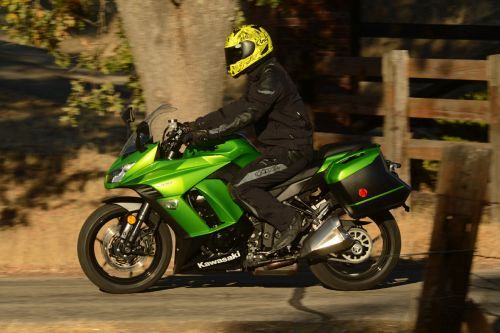The Kawasaki Concours 14 is a world-class sport-tourer, while the track-focused ZX-10R wears the world superbike crown. Filling a middle ground between these mission-specific models, the Ninja 1000 offers real-world sporting prowess and excellent light sport-touring capability. After 10 months piling miles on our green machine, we have a saddle-savvy appreciation for its superb reliability and versatility.
We determined early on that the fuel-injected inline-four possesses superb fueling and robust torque, so we focused on other areas to make improvements. First, we fitted Kawasaki Genuine Accessory Color-matched Quick-Release 28-liter Saddlebags ($1,269.75) and a gel seat/passenger pillion ($324.95). The helmet/jacket/backpack-swallowing convenience of these ignition-key-matched lockable hard bags proved invaluable for daily commuting and weekend adventures.
No surprises were encountered during the scheduled 3,800-mile maintenance intervals, though a solitary repair during the Ninja’s tenure involved the replacement of an AWOL hinge pin for one of its bag lids. Considering the pin is not an available Kawasaki part number, we found that a 16d eight-gage nail worked just fine. Cost? Two cents.
Looking to enhance the Ninja’s touring utility, we fitted a California Scientific clear Touring Windshield ($125; calsci.com). This simple-to-install 23.5-inch laser-cut acrylic screen provides excellent protection without any head buffeting. The screen, along with a set of Murph’s Handlebar Risers ($154; murphskits.com) that offer a 1.5-inch rise and 0.5-inch pullback, makes the Ninja an even better travel companion.
The bar riser installation was easy and allowed use of the stock cables and brake line. However, interference between the clutch perch/brake master cylinder and the risers restricts the ability to position the levers below horizontal. One fix is to remove the locator pin and rotate the riser forward. Another remedy I used involved shimming the bar outward about 3/16 inch via a pair of stacked washers between the inner bar tips and mating surfaces inside the riser.
“The higher bars mean zero weight on my wrists, which gave me that extra edge of comfort I’d want on a long journey,” said Editor-in-Chief Mark Hoyer in the logbook. “The rest of the rider triangle was pretty comfortable too. The pegs are tucked up, but even as a 6-foot-2 human, I didn’t feel cramped.”
A pair of Spider Peak Grips ($17.95; spidergrips.com) was a nice aesthetic upgrade, while its acoustical rebound core design and grippy rubber compound allowed a lighter yet more secure hold on the bars for some welcome but minor relief from the effects of vibration.
The original Bridgestone tires were replaced with plenty of tread left at 3,000 miles by Michelin Pilot Road 4 sport-touring radials ($547.90). Handling, grip, and longevity have been excellent, and the tires have managed to go 7,000 miles. Only recently have we begun to notice a wear-induced increase in steering effort and diminished neutrality.
The Ninja 1000 has been exciting to ride and trouble-free for 10,000 miles. It has proven to be a great all-day sportbike that also serves well in the daily commute. Its combination of power, reasonably light weight, and excellent performance make it feel like it’s in a class of one.












24
Comment